Bench Press Exercise
The Bench Press is a fundamental upper-body strength exercise that targets the chest, shoulders, and triceps. Performed by pressing a weighted barbell or dumbbells away from the chest while lying on a bench, it is a key movement for building upper body power and muscle mass.
Table of Contents
What is the Bench Press?
While lying on a bench, you thrust a barbell or dumbbells upward to perform the movement.
Bench presses come in a variety of forms that target distinct muscle groups. This can include lying flat, putting your hands closer together on the barbell, or lying at an inclination or descent.
Muscles Used While Performing the Bench Press
Depending on the particular variant you do, the muscles you train may change significantly; however, bench presses may activate the following muscles:
- Pectoralis major
- Anterior deltoid
- Triceps brachii
- Biceps brachii
- Serratus anterior
How to do the Bench Press?
Lay down on the seat under the bar rack. Ensure your eyes are positioned almost directly in line with the barbell rack’s uprights. Your spine remains in a neutral alignment, with your head, shoulders, and glutes resting flat against the bench. You have your feet level on the ground and spaced rather widely apart.
- Pull your shoulder blades downward to prevent your shoulders from rounding forward.
- Grip the barbell with an overhand hold, ensuring your thumbs wrap around the outside of your closed fist.
- Your upper arms are at an angle of around 45 degrees to your torso, and they are somewhat broader than shoulder-width apart.
- Keep your elbows locked as you lift the barbell off the rack. Avoid shifting the bar in an arcing motion from the rack to the chest position, as it is not recommended.
- As you slowly lower the bar to the nipple line, which is situated just above your chest, take a deep breath.
- Instead of focusing on the bar, look toward the ceiling.
- For the subsequent bench press, this is the beginning position.
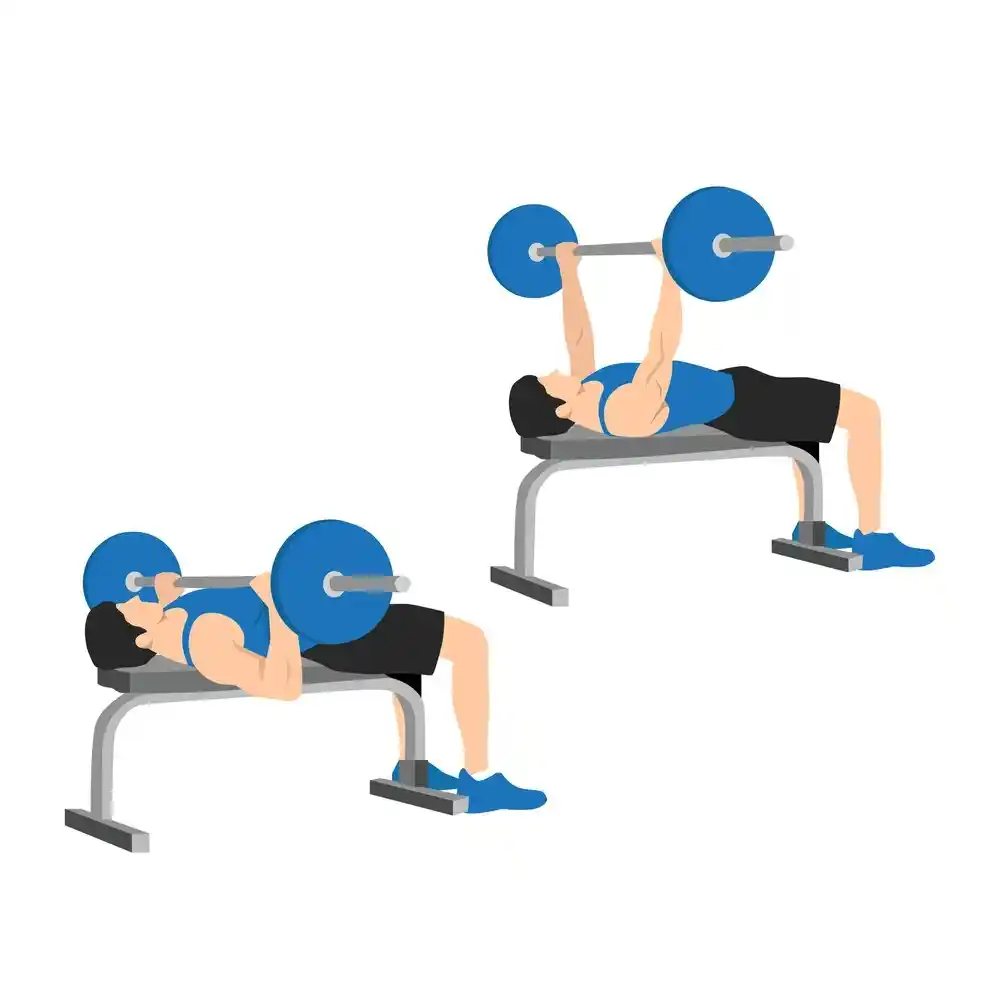
Bench Press Video
Variations In Performing the Bench Press
- Partial Bench Press
- Incline Bench Press
- Decline Bench Press
- Narrow grip bench press
- Dumbbell bench press
Partial Bench Press: If you’re concerned about shoulder joint stability, avoid lowering the weight beyond the point where your upper arms are parallel to the floor. Even though you might not be able to use the entire range of motion, this modification lessens shoulder strain.
Incline Bench Press:
- With your feet flat on the floor, lean back a little till your back is neutrally supported by the bench.
- To start, hold dumbbells or a barbell straight over your shoulders. Your thumb should be wrapped around the handle with your hands pointing front.
- Raise the weight above your eyes or just above them while keeping your elbows at a 45-degree angle.
- With your elbows and wrists still out to the sides, take a deep breath and carefully drop the dumbbells or barbell until they contact or reach just above your chest.
- Perform at least five repetitions of the press. Keep in mind that the weight and your objectives determine how many repetitions you need to complete. A person who uses greater weights could perform fewer repetitions than a person who uses lighter weights.
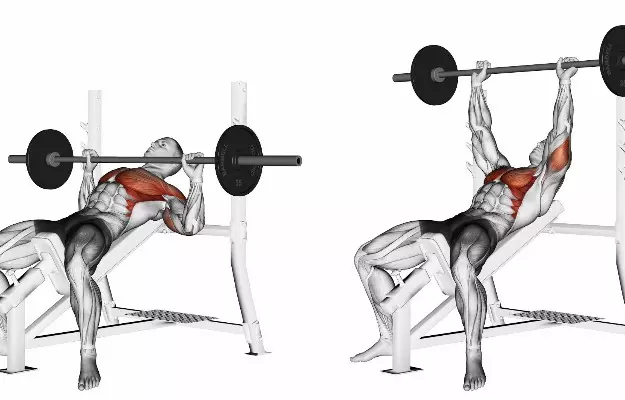
Decline Bench Press:
- On the decline bench, carefully lower yourself until your legs are higher than your head, while keeping your back strong. Make use of the foot stirrups that are supplied.
- Get a spotter to assist you in grasping dumbbells if you’re using them or in raising the bar off the rack. Arms should be slightly broader than shoulder height, and the weight should be held straight over the shoulders.
- The weight should be pushed upward until your arms are at a 45-degree angle.
- Perform at least five repetitions of the press. Keep in mind that the weight and your objectives determine how many repetitions you need to complete.
- A person who uses greater weights could perform fewer repetitions than a person who uses lighter weights.
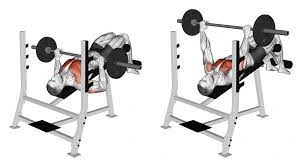
Narrow grip bench press:
- flat bench, barbell (extra weights optional),
- Follow the above instructions to perform a standard bench press, but keep your hands shoulder-width apart while holding the barbell.
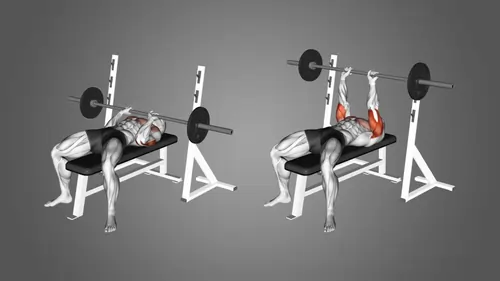
Dumbbell bench press:
- With your feet flat on the floor, lower your body beneath the weight bar. A 90-degree bend in your knee is ideal.
- In the second phase, each hand should grasp a dumbbell. With the dumbbells over your armpits, place your palms away from your body.
- The third step is to press the weights directly up toward the ceiling. When utilizing the bench, keep your wrists straight and your back level.
- The weight should be reduced until it almost reaches your underarms. Hold on a moment.
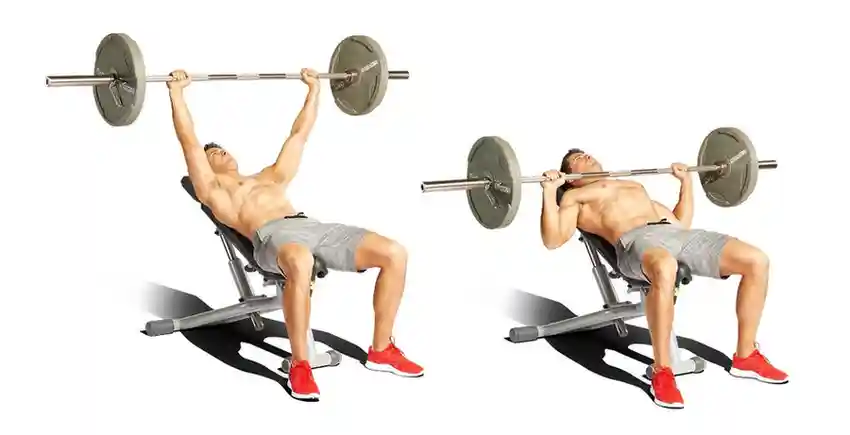
Benefits of Performing the Bench Press
- Bench presses strengthen upper-body muscles
- Bench presses increase muscle mass and endurance
- Bench presses support strong bones
- Bench presses promote heart health
- Bench presses may improve athletic performance
- Bench presses provide a versatile exercise
Common Mistakes To Avoid While Performing the Bench Press
- Moving Bar Over the Mouth or Neck
- Improper Grip Width
- Incorrect Thumb Position
- Locking Elbows Suddenly
- Pushing Head Into Bench
- Arching Back and Lifting Buttocks
Moving the Bar Over the Mouth or Neck: Take care to avoid bringing the bar too far down over the mouth or neck when racking or unracking it. Instead of lowering your arms over your face and neck, extend them when transferring the weight to and from the rack.
Incorrect Grip Width: When you grab the bar, your elbow joints should be at least at right angles, and your forearms should be perpendicular to the ground. Your pectoral muscles might be harmed if your elbows are stretched out and your grasp is excessively broad.
Incorrect Thumb Position: The thumb position is another issue that stems from grip. Place your thumbs across the tops of your fingers and beneath the bar for an overhand hold. Keep your thumbs behind your fingers rather than grasping them behind the bar.
Locking Elbows Suddenly: When performing a bench press, you can “lock out” your elbows, which is contrary to certain weightlifting safety guidelines.
The secret to doing this safely is to avoid locking your elbows abruptly or violently.
Pushing Head Against Bench: For stability, position your feet safely on the floor and rest your head straight on the bench.
Lifting Buttocks and Arching Back: The purpose of the bench press is to maintain flat buttocks on the bench. Avoid arching your back to the point where your glutes rise off the bench, as is done by powerlifters. Lower back pain may arise if you do this.
Safety and Precautions
- If you are injured in your shoulder, stay away from this workout. Replace the weights and stop the exercise right away if you have any shoulder pain while performing the bench press.
- Bench presses that don’t require weight on the bar allow beginners to warm up, feel the bar, and acquire proper technique. Use a spotter if you are more experienced and perform big weight bench presses.
- This rack features bars positioned at chest height on both sides. In case your lift fails, the bars on a power rack prevent the barbell from crushing your chest.
- Begin by performing three sets of ten repetitions with an unweighted barbell. As you become capable of this workout with the appropriate method and security, increase the weight. Every week, add two and a half pounds to each side.
Summary
- The bench press is a center upper-body workout that improves quality in the chest, arms, and shoulders.
- There are several variations—including incline, decline, partial, narrow-grip, and dumbbell presses—that target different muscle groups and accommodate various fitness levels.
- The primary muscles that are engaged include the pectoralis major, deltoids, triceps, and serratus anterior. To perform the bench press safely and effectively, maintaining proper form and grip and avoiding common mistakes like arching the back or improper thumb positioning is essential.
- Benefits include increased muscle mass, endurance, bone quality, and athletic performance. Safety precautions—such as using a spotter, starting with light weights, and using a power rack—are vital, especially for beginners or those lifting heavy weights.
FAQ’s
You may strengthen your arms, chest, and shoulders by performing bench presses. Seek assistance from a spotter if you’re new to the bench press. They may check your form and ensure that you’re using the right amount of weight for your level of fitness.
To start, a beginner who weighs 75 kg (165 lbs) can try to bench press between 37.5 kg (83 lbs) and 75 kg (165 lbs), gradually increasing from there.
Not straight! The bench press is a popular exercise for strengthening the upper body, but its primary concentration is on the chest, shoulders, and triceps. To decrease belly fat, you’ll need a more comprehensive plan in addition to the bench press exercises.
This workout strains your shoulder joint, which isn’t designed to support this much weight. Because of this, improper bench pressing technique might result in injury. Free weights (such as those used in bench presses) are more likely to be damaged than weightlifting equipment or bands.
References:
- Rogers, P. (2024, August 20). How to bench press: proper form, variations, and common mistakes. Verywell Fit. https://www.verywellfit.com/how-to-do-the-bench-press-exercise-3498278
- Chertoff, J. (2023, May 24). What muscles does the bench press work? Healthline. https://www.healthline.com/health/exercise-fitness/bench-press-muscles-worked

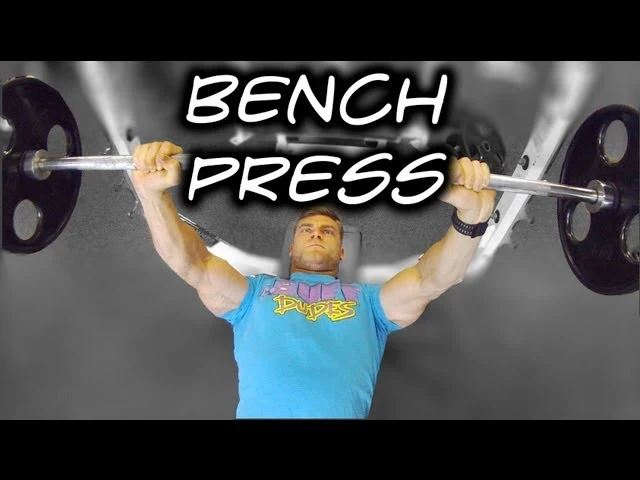

![Chair Poses [Utkatasana]](https://mobilephysiotherapyclinic.net/wp-content/uploads/2023/12/Chair-PosesUtkatasana.webp)



